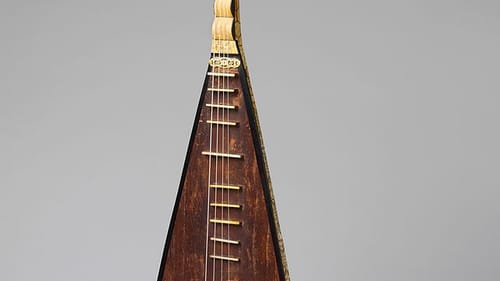Stay in the Loop
BSR publishes on a weekly schedule, with an email newsletter every Wednesday and Thursday morning. There’s no paywall, and subscribing is always free.
Pipa perfection
The Chamber Orchestra of Philadelphia presents Wu Man

The pipa, a four-stringed instrument from China, starred in the latest concert in the “Migrations” series of the Chamber Orchestra of Philadelphia. Performed by Wu Man, widely regarded as the world’s leading pipa instrumentalist, the program proved how well Eastern and Western instruments can speak to each other and to a diverse audience of listeners.
The pipa is a teardrop-shaped wooden instrument with 20-some frets that the musician plucks, slaps, strums, and taps while in a seated position. It looks a bit like a Western lute, but once the sound pours forth from Wu Man’s agile, plastic-sheathed fingertips, the comparison with the soft-voiced Western instrument quickly ends.
Commanding the Perelman
Of course, it does make a difference that today’s pipa has brilliant metal strings that resonate and project much more effectively than those of its Western cousin. The pipa is no frail wraith for a night of moon-gazing over the Yangtze River. Rather, it holds its own. On Sunday, it commanded the Perelman Theater in solo selections and in partnership with the 20-member string ensemble, led by Chamber Orchestra music director Dirk Brossé.
A performer of charm and warmth, Wu Man entered the stage cradling the pipa as one would a young child. Wearing a brightly colored tunic and kelly-green tights, she immediately anchored a performance of “The Shepherd Girl,” a haunting traditional melody that Brossé scored for the small orchestra with a magic touch.
Glenn Fischbach, acting principal cellist, transformed the cello into an instrument of two worlds, delicately finessing Eastern-style glissandi — an effect that can be cheesy in the wrong hands but was heartbreakingly poignant in his. Acting concertmaster Meichen Liao-Barnes mirrored these effects with feeling and technical mastery, along with Yoshihiko Nakano, acting principal violist. Through Brossé’s imaginative invention, the work expanded from a humble tune to a full realization for chamber orchestra, delightful in every way.
Classic and contemporary
The pipa’s range of expressive power was demonstrated in a traditional solo, “White Snow in Spring.” But it was in the concluding work, Lou Harrison’s Concerto for Pipa with String Orchestra, that the pipa’s contemporary relevance emerged. The work was composed for Wu Man in 1997 and is quite the masterpiece in its own right.

Its seven parts (four movements, one of which has four subsections) contain a wealth of variety and appeal. In the subsection “Three Sharing,” the pipa, cello, and bass focus on their percussive qualities and carry on a conversation such as we might encounter during an Indian jugalbandi (usually two stellar instrumentalists performing together).
Another remarkable part of the concerto was the third movement, “Threnody for Richard Locke,” a touching elegy in memory of the actor and AIDS activist who died in 1996. Brossé conducted with a sure touch and with his palpable enthusiasm for the music of our time.
All this and Mozart too
But there was more to the Chamber Orchestra’s program than the inimitable pipa. The first half of the concert was dedicated to two stalwarts of the string symphonic repertoire, Mozart’s Divertimento in F major, K. 138; and Antonin Dvořák’s Serenade in E major, Op. 22. Thanks to the miracle of classical radio, these works may be very familiar to casual listeners around the world, not just collectors and connoisseurs, with hummable tunes in each of three movements.
This is Mozart at his fresh young best, brisk and light in the first movement, with a few circumspect patches in the minor mode. The second movement yields subterranean springs of melody in the lower registers, below the bright tunes above. The concluding movement was quick, perhaps a little too quick for my taste (though it is presto), with a whimsical attitude and an abrupt but satisfying end. You can almost hear the splash of wine glasses and the giggles of women with tall white wigs teetering.
Another work for light occasions, Dvořák’s Serenade has five movements, filled with bohemian tunes and syncopated dance rhythms. Sonorous and wistful, the music unfolds under Brossé’s caress like a bird of paradise in bloom, with no object save our delight.
What, When, Where
The Chamber Orchestra of Philadelphia. Dirk Brossé, conductor; Wu Man, pipa soloist. Wolfgang Mozart’s Divertimento in F major, K. 138; Antonin Dvořák’s Serenade in E major, Op. 22; “The Shepherd Girl,” traditional, arr. Brossé; Interlude (“White Snow in Spring”); Lou Harrison’s Concerto for Pipa with String Orchestra. December 9 and 10, 2018, at the Kimmel Center’s Perelman Theater, 300 S. Broad Street, Philadelphia. (215) 545-5451 or chamberorchestra.org.
Sign up for our newsletter
All of the week's new articles, all in one place. Sign up for the free weekly BSR newsletters, and don't miss a conversation.

 Linda Holt
Linda Holt